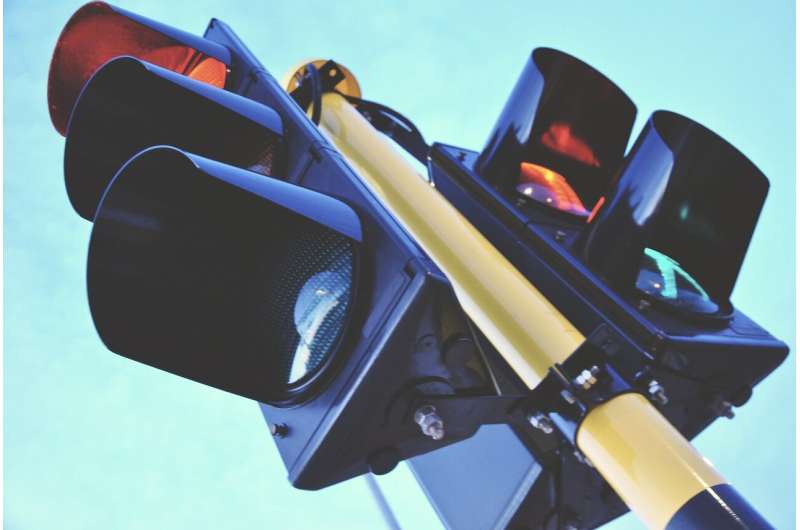Credit: CC0 Public Domain
Could a solution to traffic lights going dark in big storms come from the Florida sun? The city of Tampa is looking to find out.
In a pilot program, the city has installed 84 solar panels on the surface of a downtown sidewalk near the intersection of Jefferson and Cass streets to soak up the abundant sunlight and power the traffic signal there.
Next to that solar-paneled stretch of sidewalk is a tall white cabinet that contains the necessary equipment and is printed with an explanation for curious passersby.
"This intersection is powered by solar energy and will continue to operate even if the electricity goes out," it reads. "The signal stays on."
The solar-powered system, up and running since September, generates about 3/4 of the overall power needed for the traffic signal at that intersection, with 25% provided by old-school electricity, according to city officials. They hope to work toward 100% solar power.
The idea for a sun-powered traffic light came up after 2017′s Hurricane Irma, said Brandon Campbell, the city's smart mobility manager. The rough weather did its traditional job of knocking out power to traffic lights.
Getting through such intersections post-storm is potentially dangerous, particularly when it's dark, when motorists are unfamiliar with the area or when they don't know they are supposed to treat such intersections as four-way stops.
Tampa has about 35 generators ready to be deployed when traffic lights are out, Campbell said. With the effects of this year's Hurricane Ian, "we had 71 signals that were dark," he said.
Even with generators deployed—a time consuming process—at the end of the day a few signals were still operating via by stop signs, he said.
Backup batteries that are in about half the city's traffic lights can last about eight hours, Campbell said. The test intersection can run on solar power alone for about three days.
The city picked that particular place on the north side of downtown next to Perry Harvey Sr. Park for the test program because it's a low-speed area and an access route to the interstate, Campbell said. It's also not shaded by downtown's tallest buildings and is one of the newer signals.
"A lot of factors came together in one spot that made it ideal for testing something that was potentially helpful for critical needs," he said.
City officials did not get to test the solar project after the recent tropical system Nicole because downtown traffic lights didn't lose power, Campbell said. The solar signal "continued to generate power through that day of cloudiness," he said.
Tampa worked on the project with with a Vancouver-based company called Solar Earth Solutions. The effort cost $45,000, with the city doing the installation starting in 2020.
Campbell said he doesn't know of another city with a solar project like this one. Officials are hoping to leverage it to garner further funding, such as a U.S. Department of Transportation grant, and add solar to more signals.
"We're excited about what it represents and the potential for taking it further," he said. "I think it's pretty innovative. I think there's some excitement building."
2022 Tampa Bay Times.
Distributed by Tribune Content Agency, LLC.























